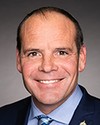Thanks for the question.
From my perspective as somebody who's spent a career in rural development and, previous to that, in the media, it would be nice if the federal government got serious about rural development, full stop. We have not had leadership on that file for half a century, whether it's economic development, transportation, trade or defence. That's the first thing.
The second thing is this: Where I see a federal role is in the interprovincial piece. Jurisdictionally, transportation is, in my view, primarily the responsibility of the provincial governments. That's where the leadership should be coming from. However, the federal government can lead by helping to incentivize the provinces and territories to work together in order to have an integrated system that will travel across provinces.
From a British Columbia perspective, we're already doing this in northern B.C. Our intent is that, within two to three years, what we've built will expand across the entire province. However, our influence and ability end at our borders. It would be really nice to have that integrated with other provinces and, as one of the earlier speakers said, integrated with the U.S. system as well. That's critically important for the movement of people in North America.
That is where federal leadership should come in. It does take leadership. It takes direction, but I don't think it takes a ton of money. You can do these things very effectively by building on solutions that are already operating in jurisdictions throughout Canada, linking them together and enforcing collaboration in the way we've been able to achieve in northern B.C.




